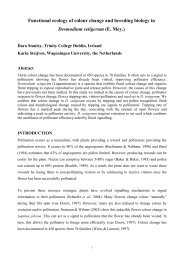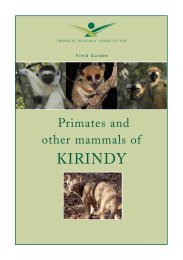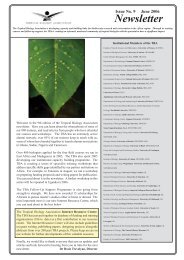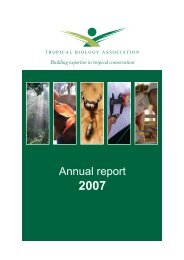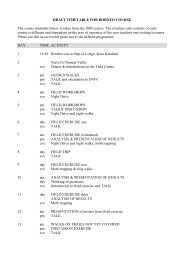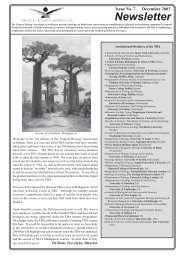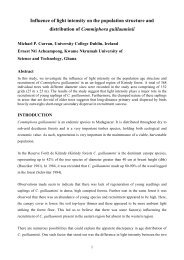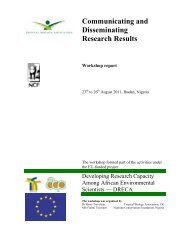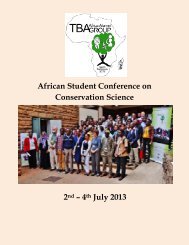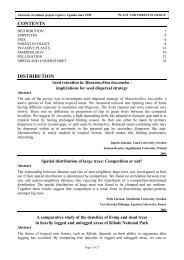Download TAAG Book of Abstracts - Tropical Biology Association
Download TAAG Book of Abstracts - Tropical Biology Association
Download TAAG Book of Abstracts - Tropical Biology Association
Create successful ePaper yourself
Turn your PDF publications into a flip-book with our unique Google optimized e-Paper software.
Distribution Status <strong>of</strong> Two Endemic Dwarf Chameleon<br />
Nadzika mbiamlanjensis and Rampholeonplatyceps on<br />
Mt Mulanje, Malawi<br />
1 *YankhoChapeta, 2 Enoch Ng’oma, 1 Tiwonge I Mzumara<br />
1 Museums <strong>of</strong> Malawi, Natural History Department, Top<br />
Mandala, P.O Box 30360, Chichiri, Blantyre 3<br />
2 <strong>Biology</strong> <strong>of</strong> Ageing, Friedrich-Schiller University, Jena,<br />
Germany<br />
*Email for correspondence:<br />
yankhochapeta@yahoo.com<br />
Abstract<br />
The dwarf chameleon, Nadzikambia mlanjensis<br />
constitutes a small population strictly endemic to Mt.<br />
Mulanje. The diminishing coverage <strong>of</strong> Montane Forest,<br />
primarily due to logging, is suspected to impact<br />
negatively on the population <strong>of</strong> N. mlanjensis. We<br />
investigated the current population status <strong>of</strong> N.<br />
mlanjensis by quantifying the frequency <strong>of</strong> encounters<br />
during forest searches in the wet and dry seasons. We<br />
also carried out analysis <strong>of</strong> genetic diversity in 16S and<br />
Prlr genes. The significance <strong>of</strong> indigenous practices<br />
towards its conservation was assessed through<br />
structured questionnaire interviews. Out <strong>of</strong> the 57<br />
chameleons encountered in 92 hours <strong>of</strong> search, none<br />
was N. mlanjensis. Instead, all <strong>of</strong> them belonged to a<br />
related dwarf chameleon, Rampholeonplatyceps which<br />
appeared to be genetically unstructured, generally<br />
showed high nucleotide diversity, and did not depart<br />
from neutrality. The absence <strong>of</strong> N. mlanjensis in our<br />
sample suggests that it is becoming very rare in the<br />
massif likely as a result <strong>of</strong> habitat transformation. This<br />
finding therefore calls for a quick intervention to save<br />
the endemic Mulanje dwarf chameleon. On a positive<br />
note, a biocultural survey indicates that although people<br />
have a bad perception about chameleons, very few are<br />
willing to kill them, providing a starting point towards<br />
their conservation.<br />
Keywords:N. mlanjensis, R. platyceps, endemic, Mt.<br />
Mulanje, conservation status, intervention<br />
Floristic composition, structure and species<br />
associations <strong>of</strong> dry Miombo woodland in Tanzania<br />
* 1,2 Ezekiel Edward Mwakalukwa, 1 Henrik Meilby and<br />
1 Thorsten Treue<br />
1 Danish Centre for Forest, Landscape and Planning, Faculty <strong>of</strong><br />
Science, University <strong>of</strong> Copenhagen, Rolighedsvej 23, 1958<br />
Frederiksberg C, Denmark<br />
2 Department <strong>of</strong> Forest <strong>Biology</strong>, Faculty <strong>of</strong> Forestry and Nature<br />
Conservation, Sokoine University <strong>of</strong> Agriculture, P. O. Box<br />
3010, Chuo Kikuu, Morogoro, Tanzania<br />
*Email for correspond: Email- ezedwa@yahoo.com<br />
Abstract<br />
Biodiversity information for majority <strong>of</strong> forest reserves in<br />
Tanzania is poorly documented. This study contributes<br />
baseline data on species diversity, richness and forest<br />
structure, and attempts to understand the relationship<br />
between species occurrence and topographic and edaphic<br />
factors in the dry miombo woodland <strong>of</strong> Iringa rural district,<br />
Tanzania. The study is based on 35 nested circular plots<br />
with radii <strong>of</strong> 5, 15 and 20 m that were distributed regularly<br />
along transect lines across a 6,065 ha community-managed<br />
forest area. Seedlings <strong>of</strong> all species with diameter < 1 cm<br />
and saplings with diameter < 5 cm were identified and<br />
counted within 5 m plots while adults with diameter ≥ 5 cm<br />
were identified and counted within 5 m plots. The species<br />
<strong>of</strong> felled trees was identified and the stumps were<br />
measured 20 cm above ground within 20 m plots. Soil<br />
samples were collected from depths <strong>of</strong> 0-15 cm and 15-30<br />
cm and elevation measured within each <strong>of</strong> the plots. A<br />
total <strong>of</strong> 88 woody species belonging to 29 families were<br />
identified with family Caesalpiniaceae rank on top with 11<br />
species; a typical characteristic <strong>of</strong> Miombo vegetation.<br />
Shannon-Wiener and Simpson diversity indices for adults<br />
were 3.44 and 0.05 respectively. Mean stem density, basal<br />
area and volume were 1,521 stems/ha, 14m 2 /ha and<br />
92m 3 /ha respectively. Elevation, soil texture, soil pH, base<br />
saturation percentage, and C:N ratio strongly correlated<br />
with the occurrence <strong>of</strong> the four plant communities namely<br />
Brachystegia spiciformis – Diplorynchus condylocarpon –<br />
Lannea schweinfurthii woodland; Dalbergia arbutifolia –<br />
Commiphora africana – Albizia petersiana woodland;<br />
Acacia sp. – Acacia abyssinica – Albizia amara woodland,<br />
and Bauhinia petersiana –Shrebera trichoclada woodland.<br />
The results indicate high level <strong>of</strong> diversity in the forest<br />
which requires special effort in conservation and avoiding<br />
further deforestation through preparation <strong>of</strong> the updated<br />
and proper management plans.<br />
Keywords: Biodiversity, deforestation, environmental<br />
factors, NMS ordination, plant communities.<br />
<strong>TAAG</strong> First African Student’s Conference, Nairobi. 2-4 July, 2013 27




